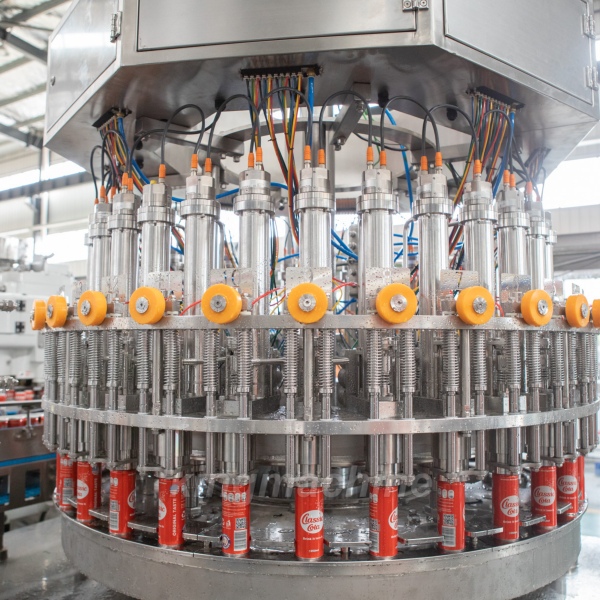The global beverage industry is experiencing extraordinary growth in canned products—from carbonated soft drinks and beer to energy drinks, sparkling water, RTD tea and coffee, and functional health beverages. As demand surges, beverage manufacturers are faced with rising expectations for product quality, sustainability, efficiency, and safety. This evolution has accelerated major advancements in can filling technology, especially in terms of precision filling, oxygen management, automation, hygienic design, and production speed.
Modern can filling machines are no longer just mechanical systems; they have become high-tech, digitally optimized production assets that directly influence product shelf life, taste, carbonation retention, and manufacturing cost. Understanding the latest trends in canning helps beverage companies make smarter investment decisions and stay competitive in a rapidly changing market.
1. Market Forces Driving Innovation in Can Filling Technology
Growing Demand for Canned Beverages
The market for canned beverages is expanding faster than ever. Consumers prefer aluminum cans because they are portable, light-blocking, infinitely recyclable, and able to maintain carbonation better than many other packaging formats. Craft beverage producers and multinational brands alike are increasing their canned SKU lineup, pushing suppliers to design more flexible and adaptable can filling machines capable of handling a wide range of formulas.
Strong Sustainability Pressures
Aluminum cans have one of the highest recycling rates of all beverage packaging materials, creating strong momentum toward can-based packaging. As more beverage factories pursue carbon neutrality and energy-efficient operations, can filling lines must adapt with:
انخفاض استهلاك المياه
Reduced CO₂ usage
Energy-efficient vacuum and pressure systems
Lighter aluminum cans that require gentler mechanical handling
These sustainability motivations are shaping a new generation of environmentally responsible can filling technology.
Increasing Product Variety and Production Flexibility
Modern beverage plants face shorter product cycles, seasonal flavors, and rapidly changing consumer preferences. As a result, manufacturers require can filling machines with:
Fast format changeovers
Recipe-based filling control
Ability to handle slim, sleek, and standard can sizes
Compatibility with sugary drinks, carbonated beverages, and nitrogen-infused formulas
Flexibility has become just as important as speed in today’s competitive landscape.
2. Key Technology Trends in Can Filling Machines
Advanced Counter-Pressure and Isobaric Filling Systems
Carbonated beverages require precise pressure control to retain CO₂ and avoid foaming. The newest counter-pressure can filling machines use:
Multi-stage pressurization
Stable product tank pressure
Tightly controlled snift valves
Reduced turbulence filling paths
These improvements allow manufacturers to achieve higher speeds while maintaining carbonation integrity.
Servo-Controlled Filling Valves
Servo technology is reshaping the design of modern can fillers. Instead of relying strictly on mechanical valves, today’s servo-driven filling systems offer:
More accurate fill volumes
Smooth, repeatable filling performance
Customizable filling curves for different beverages
Less maintenance due to fewer mechanical wear points
Servo systems are especially useful for plants managing mixed flavors, small batches, and premium products that require high filling precision.
Improved Oxygen Management: Double Pre-Evacuation & N₂ Injection
Minimizing TPO (Total Package Oxygen) is critical for preserving taste and shelf life, especially in beer and functional beverages. The latest can filling technologies incorporate:
Double or triple pre-evacuation
More efficient CO₂ purging
Optional nitrogen dosing before sealing
Lower oxygen pickup during filling
These improvements help extend product stability and reduce spoilage.
Hygienic, Aseptic, and Clean-Line Designs
As the variety of low-acid and health beverages increases, hygienic requirements for can filling machines have intensified. New designs offer:
Fully enclosed filling environments
Enhanced CIP (Clean-in-Place) and SIP (Sterilize-in-Place) capabilities
Smooth-welded stainless-steel frames
Sloped surfaces to prevent liquid accumulation
This makes modern can filling systems cleaner, safer, and more compliant with regulatory standards.
3. Smart Filling: Automation, Digitalization, and Industry 4.0
Real-Time Data Monitoring and Predictive Maintenance
Industry 4.0 has transformed the traditional filling line into an intelligent production system. Many modern can filling machines now come with:
Sensor-based monitoring for pressure, temperature, and flow
Real-time fill-level detection
خوارزميات الصيانة التنبؤية
Remote management dashboards
These features significantly reduce downtime and improve long-term equipment reliability.
Automated and Tool-Free Changeovers
To serve multi-SKU beverage plants, manufacturers now offer:
Automatic height adjustments
Servo-lift can tables
Tool-free filling valve swaps
Smart recipes that instantly load filling parameters
These enhancements reduce setup times by up to 80%, making canning lines far more flexible.
Vision Systems and AI-Based Quality Inspection
AI and machine vision systems are becoming standard on advanced canning lines. They monitor:
دقة مستوى التعبئة
Foaming patterns
Can lid placement
Seam quality after seaming
Foreign-object contamination
Paired with modern can seamers, these systems ensure each can meets strict quality standards.
4. Packaging-Friendly Enhancements in Can Filling Machines
Handling Lightweight Cans With Greater Precision
As aluminum becomes thinner to reduce material costs and carbon footprints, cans are more vulnerable to deformation. The newest can fillers integrate:
Smooth, low-pressure can transportation
Shock-absorbing star wheels
Non-contact can transfer systems
These changes allow high-speed production while preventing costly can damage.
Multi-Size Compatibility for Slim, Sleek, and Specialty Cans
The boom in craft beverages and niche flavors has resulted in growing demand for multiple can sizes. Innovations in can filling machine design allow:
Quick switching between 250 ml, 330 ml, and 500 ml cans
Adaptation to slim and sleek cans
High accuracy despite changing product characteristics
This flexibility is essential for brands seeking to differentiate their packaging.
5. Efficiency and Sustainability Innovations
تصاميم موفرة للطاقة
Manufacturers now incorporate:
Low-energy vacuum pumps
Highly efficient motors
Optimized mechanical motion paths
Reduced compressed air consumption
Together, these features lower operational costs while supporting sustainability goals.
CO₂ and Nitrogen Recovery Systems
Modern filling lines increasingly include:
CO₂ recycling loops
Precision nitrogen injection
Reduced CO₂ flushing requirements
These improvements reduce gas usage without compromising beverage quality.
Water Conservation and Clean-Line Improvements
Water-saving innovations include:
Dry lubrication conveyors
Waterless can rinsers
Foam-cleaning systems for filling carousels
These systems reduce water waste and improve the environmental footprint of beverage production.
6. Future Innovations in Can Filling Technology
The next generation of can filling machines will combine advanced automation, robotics, and AI-driven control. Emerging innovations include:
AI-Controlled Filling Algorithms
These systems automatically adjust filling pressure, temperature, and speed based on real-time sensor data.
Magnetic and Electro-Pneumatic Valves
Next-generation filling valves will offer faster response times and even better precision.
التكامل الروبوتي
Robots will increasingly handle:
منصات نقالة
إزالة المنصات
Carton loading
Tool-free format changes
This will create more compact, efficient, and fully automated canning lines.
7. How Beverage Manufacturers Can Prepare for the Future
To stay competitive, beverage plants should prioritize:
Investing in modular, upgradeable can filling machines
Choosing equipment that supports automation and smart control
Ensuring seamless integration with upstream and downstream systems
Adopting sustainable, low-energy can filling solutions
Selecting suppliers with strong after-sales support and technical expertise
Companies that embrace innovation early will enjoy superior product quality, lower operating costs, and greater long-term success.
الخاتمة
The landscape of can filling technology is evolving quickly. From counter-pressure filling and advanced oxygen control to smart automation and energy-efficient designs, modern systems are reshaping how beverage companies operate. As market demand for canned beverages grows and competition intensifies, adopting the latest can filling innovations is essential for achieving higher productivity, better product stability, and lower operating costs.
A state-of-the-art can filling machine is no longer optional—it is a strategic investment in consistency, efficiency, and long-term brand growth.
At the forefront of these advancements, suppliers like King machine continue to support beverage factories with cutting-edge can filling solutions and customized production line design.







